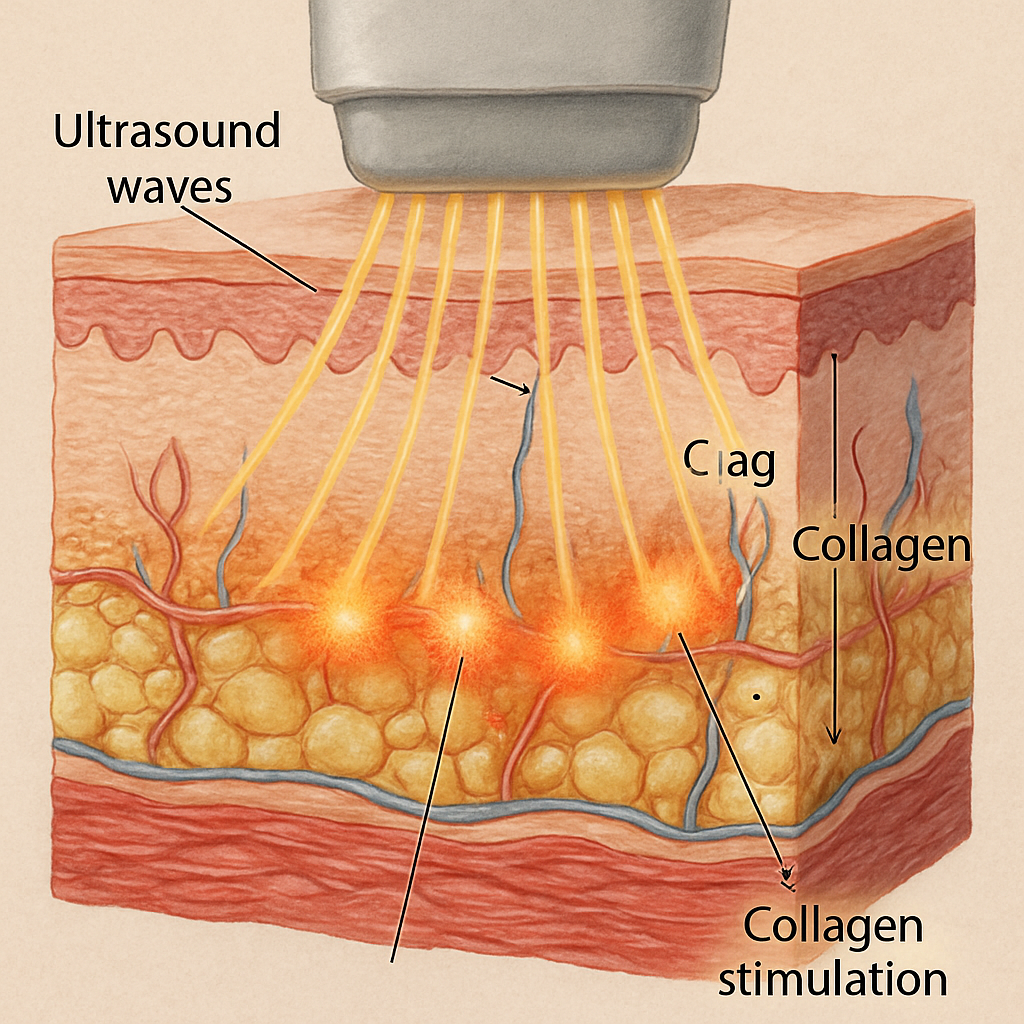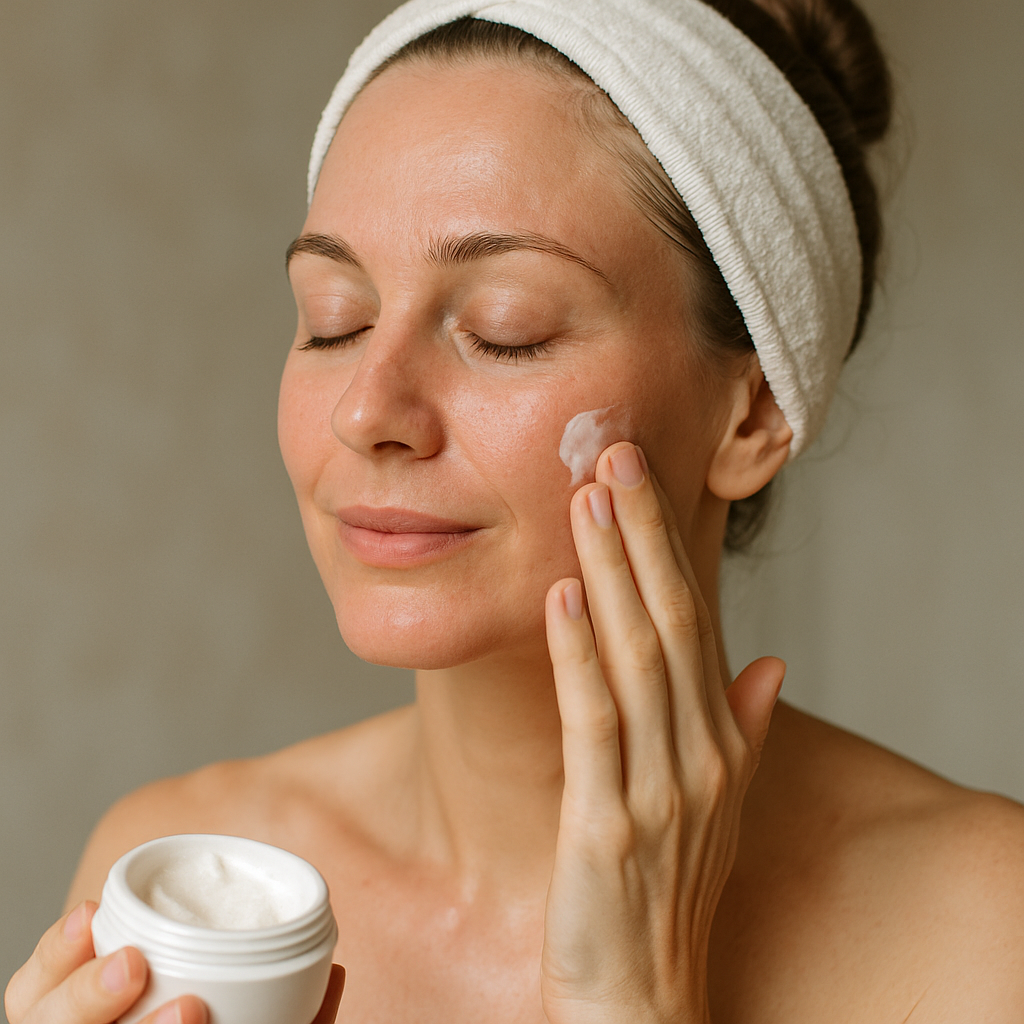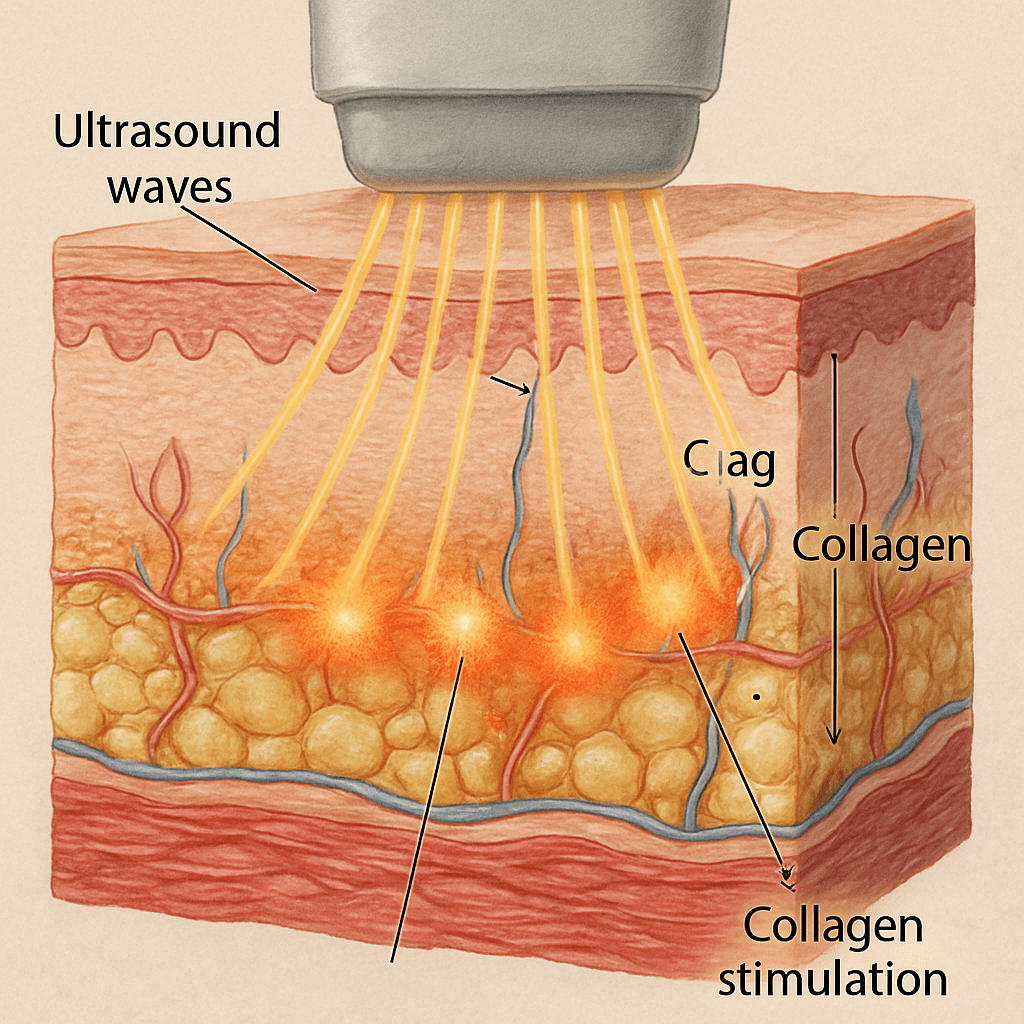Most of us want to look and feel younger without going under the knife. But what if there’s a way to tighten and lift your skin using a non-invasive technique that’s safe and effective? That’s where HIFU treatment comes in.
You might be asking, what is HIFU treatment exactly? HIFU stands for High-Intensity Focused Ultrasound, a cutting-edge technology that uses ultrasound energy to target deep layers beneath the skin. This energy stimulates collagen production—the key protein that keeps your skin firm and youthful.
Unlike surgical facelifts or aggressive procedures, HIFU is non-surgical and requires no downtime. It works by delivering focused ultrasound waves to precise depths under the skin, encouraging natural regeneration. The result? Noticeably tighter, smoother skin with fewer wrinkles over time.
Are you worried about whether it’s effective for your specific needs? HIFU is versatile and can treat multiple areas: from lifting sagging cheeks and jawlines to reducing wrinkles around the eyes and forehead. It’s also becoming popular for men and women looking for non-surgical rejuvenation and even hair restoration.
Why does it matter? Because HIFU offers an accessible solution for those who want to improve their appearance without the risks of surgery or long recovery periods. Many of our clients at Simcoe Cosmetic Clinic have found it to be a game-changer for their anti-aging routines.
If you’re curious about how HIFU compares to other treatments like Botox or dermal fillers, you might want to check out our expert insights on Botox in Barrie. Understanding your options helps you make the best choice for your skin goals.
Ready to discover the benefits of modern skin rejuvenation? Let’s dive in and explore everything you need to know about this innovative treatment that’s reshaping how we approach skincare at Simcoe Cosmetic Clinic.
TL;DR: A Quick Overview of HIFU Treatment
Wondering what is HIFU treatment? It’s a safe, non-surgical procedure that uses focused ultrasound to naturally lift and tighten your skin without downtime.
Perfect for reducing wrinkles, lifting sagging skin, and even restoring hair, it’s ideal if you want youthful results without surgery.
Step 1: How HIFU Treatment Works on the Skin
If you’re wondering what is HIFU treatment and how exactly it works, you’re not alone. Understanding the science behind this popular non-surgical skin rejuvenation method will put your mind at ease and help you set realistic expectations for your results.
Getting to Know the Basics of HIFU
HIFU stands for High-Intensity Focused Ultrasound. Unlike traditional ultrasound used in medical imaging, HIFU uses focused ultrasound waves to penetrate deep into the skin layers without damaging the surface. This energy specifically targets the deeper layers beneath the skin’s surface, usually between 1.5mm to 4.5mm in depth, reaching the connective tissue and muscle layers that support your skin’s structure.
But why does targeting those depths matter? Well, over time, collagen and elastin—the proteins responsible for your skin’s firmness and elasticity—begin to break down, leading to sagging and wrinkles. HIFU treatment aims to reverse this by stimulating your body’s natural collagen production.
What Happens During HIFU Treatment?
During the procedure, a practitioner uses a handheld device that delivers ultrasound energy precisely to the desired layers of your skin. This energy causes controlled heating of the tissue at specific depths, usually reaching temperatures between 60°C and 70°C. This heat creates micro-injuries, which might sound scary but is actually a good thing. These micro-injuries act as a signal to your body to kickstart the healing process—producing new collagen and elastin fibers to repair and strengthen the tissue.
Think of it as a natural skin workout. Just like muscles get stronger after exercise-induced micro-tears, your skin tightens and firms as it heals from these ultrasound-induced micro-injuries.
Why No Surface Damage?
You might be concerned about pain or visible damage on the skin’s surface, but here’s the cool part: the ultrasound waves pass through the outer skin layers, targeting only the deeper layers where collagen is formed. This means your skin’s surface remains unharmed, and there’s minimal discomfort and no downtime.
This is a big advantage over surgical facelifts or invasive treatments, which require recovery time and carry greater risks.
How Collagen Renewal Translates into Visible Results
The new collagen your body produces after HIFU gradually rebuilds the skin’s support structure over several weeks to months. This process results in smoother, tighter, and more youthful skin. The collagen boost can reduce the appearance of wrinkles, lift sagging skin, and improve overall skin texture.
Keep in mind, the effects aren’t instant. It typically takes around 2 to 3 months to see the full results as collagen regeneration takes time. And the good news? These results can last anywhere from 6 to 18 months depending on your skin condition and lifestyle.
Is HIFU Safe and Effective?
HIFU is FDA-approved for skin tightening and lifting, which means it has passed strict safety evaluations. However, because HIFU doesn’t include imaging technology to visualize the layers beneath your skin during treatment, it requires skilled practitioners who understand the anatomy and can precisely target the right depths to avoid hitting muscles or bones.
For a deeper dive into how HIFU compares to other ultrasound-based treatments, you can check out this detailed comparison at the Cosmetic Skin Clinic’s article on Ultherapy vs HIFU. It explains why knowing how treatment works beneath the skin is crucial.
Curious about how aesthetic clinics incorporate HIFU into their services and patient outcomes? Radiance Skin Clinic offers a comprehensive look at everything you need to know about HIFU skin tightening, focusing on how this treatment supports natural skin revitalization.
So, does this really work for everyone? While HIFU is effective for many, it’s best suited for those starting to notice mild to moderate skin laxity rather than very advanced sagging. If you’re looking for a non-surgical method to kickstart your skin’s collagen production and enjoy gradual lifting and tightening, it’s definitely worth considering.

Step 2: Preparing for Your HIFU Treatment Session
So, you’re curious about what is HIFU treatment and ready to take the next step. Preparation is key to ensure your session goes smoothly and you get the best possible results. At Simcoe Cosmetic Clinic, we believe that a little prep work beforehand makes all the difference—both for comfort and outcome.
Consultation: Your First Step
Before your actual session, you’ll have a detailed consultation with our trained specialists. This is your time to share your skin concerns, goals, and any medical history that might affect your treatment. Why is this important? Because HIFU treatment works best when it’s tailored specifically to your skin type and condition.
During this visit, we’ll explain how the ultrasound energy penetrates beneath the skin surface to stimulate collagen production. Understanding this process helps set realistic expectations and lets you ask any burning questions you might have about the procedure or results.
Skin Care Prep: Get Your Skin Ready
In the days leading up to your HIFU session, it pays to show your skin some love. Avoid excessive sun exposure and steer clear of tanning beds, as sunburned or sensitive skin can increase the risk of discomfort during treatment.
Also, stay away from harsh facial treatments like chemical peels, microdermabrasion, or laser therapy at least two weeks before your appointment. These can make your skin more sensitive or irritated, which isn’t ideal when you’re about to have ultrasound energy focused deep into your layers.
Stick to a gentle skincare routine with soothing cleansers and hydrating moisturizers. If you’re unsure what products to use, our specialists can recommend suitable options that won’t interfere with your procedure.
What to Expect on Treatment Day
Arriving on time and with a clean face helps the session begin without delays. You might want to skip makeup or heavy creams that day, so your skin is clear for the ultrasound device.
During the procedure, a cooling gel is often applied to your skin. This isn’t just refreshing—it helps conduct the ultrasound waves safely and comfortably. You may feel mild warmth or tiny pulses as the energy targets the deeper layers, stimulating collagen but without cutting or injections.
Wondering if you’ll need anesthesia? The good news is that most people tolerate the treatment well without it. If you have any concerns about pain, discuss them during your consultation so we can adapt your session to suit your comfort level.
Plan for Post-Treatment Care
Though HIFU is non-invasive with minimal downtime, it’s wise to arrange your day so you can relax afterward. Avoid strenuous exercise, hot baths, or direct sun exposure immediately following your treatment to allow your skin to recover without irritation.
And here’s a tip: invest in a high-quality sunscreen to protect your newly stimulated skin from UV damage. Proper protection supports collagen regeneration and prolongs your results.
Remember, each treatment session is just one part of your journey to youthful skin. How you prepare plays a huge role in maximizing benefits. If you want to explore more about effective HIFU pre- and post-care routines, check out the expert advice provided by Elite Body Contouring and insights into managing realistic outcomes at Inspired Beauty Medspa.
To make this even clearer, here’s a short how-to checklist for preparing your session:
- Attend your consultation and discuss your skin goals openly.
- Avoid sun exposure and harsh skin treatments at least two weeks before.
- Stick to gentle skincare products and stay hydrated.
- Arrive with a clean, makeup-free face on treatment day.
- Prepare to relax after your session and protect your skin from UV rays.
Are you ready to get started? Watch this quick video to see what a HIFU treatment session looks like at Simcoe Cosmetic Clinic and how comfortable it can be!
Preparing well doesn’t just make the day of treatment easier; it sets the stage for glowing, firmer skin in the months to come. At Simcoe Cosmetic Clinic, we’re here to guide you through each step—making your journey towards refreshed, youthful skin as smooth and rewarding as possible.
Step 3: What to Expect During and Immediately After HIFU Treatment
Wondering what exactly happens during a HIFU session at Simcoe Cosmetic Clinic? Knowing what to expect can calm nerves and help you feel fully prepared.
Getting Started: The Treatment Setup
Before the procedure begins, your skin will be cleansed and a cooling gel applied to the targeted area. This gel helps conduct the ultrasound energy effectively. Unlike many invasive treatments, there’s generally no need for anesthesia—though a topical numbing cream can be offered if you’re particularly sensitive.
Your provider will place the HIFU device carefully on your skin, targeting the exact depths needed to stimulate collagen regeneration without any cutting or injections.
The Sensations: What Does HIFU Feel Like?
Many people ask, “Is HIFU painful?” The honest answer is: it varies. Most describe a tingling warmth or slight prickling sensation with occasional sharper pulses that correspond to the bursts of ultrasound energy delivered. Think of it like tiny warm zaps beneath the surface—not quite pain, but definitely noticeable.
If you feel uncomfortable, your technician will adjust settings or pause briefly. This level of control ensures your comfort while maximizing treatment benefits. The entire procedure generally lasts between 30 minutes to 2 hours depending on the size of the area treated.
Immediately After: How Will Your Skin React?
Right after your session, you might notice mild redness, swelling, or a tight sensation in the treated area. These effects are quite normal and often resemble a mild sunburn feeling, typically fading within a few hours or days. Some experience slight tenderness or tingling—these sensations signal your skin’s healing and collagen-building process has kicked off.
Good news: Because HIFU is non-invasive, there’s minimal downtime. Most clients head home right after treatment and can return to their usual activities almost immediately. However, it’s wise to avoid direct sun exposure and protect your skin with SPF as it heals.
Tips to Ease Any Discomfort
Trouble sleeping or feeling some soreness? Over-the-counter pain relievers like ibuprofen can help manage any mild discomfort. Applying a cold compress to the area also works wonders in reducing swelling and calming heat sensations.
Keeping yourself well-hydrated supports the healing process, so drink plenty of water in the days following your treatment.
Remember, the Real Magic Is in What Happens Next
Your skin won’t look dramatically different immediately after the session. That’s normal! Collagen production ramps up gradually, and noticeable results unfold over the coming weeks and months. Patience here pays off with firmer, smoother, and younger-looking skin.
Curious about more detailed insights on managing expectations and the subtle discomfort of HIFU? The team at Continental Hospitals offers an excellent overview of what sensations to expect, while Yale Medicine highlights the precision and noninvasive nature of HIFU, affirming why many prefer this to surgical options.
Simply put, understanding what is HIFU treatment and how it feels during and after can help you approach your appointment with confidence and excitement. Ready to enjoy the journey to rejuvenated skin? We’re here to guide you every step of the way.
Step 4: Post-Treatment Care and Optimal Results with HIFU
So, you’ve just experienced HIFU treatment—exciting, right? But what happens next is just as important as the session itself. Proper post-treatment care can make all the difference in how quickly you heal and how stunning your results turn out.
Immediate Aftercare: Soothe and Protect
In the critical first 24 hours after your HIFU session, your skin is sensitive and vulnerable. A gentle, cool compress applied to the treated areas helps calm any warmth or redness caused by the ultrasound energy. Avoid rubbing or applying pressure; simply let your skin relax and recover.
Hydration is your skin’s new best friend. Drink plenty of water to support collagen synthesis and tissue healing from the inside out. At the same time, use a fragrance-free, rich moisturizer to lock in hydration externally and soothe your skin.
Don’t forget sunscreen. Your skin is more susceptible to UV damage after treatment, so apply a high-SPF sunscreen every day and try to avoid direct sun exposure. Protecting your skin prevents hyperpigmentation and preserves the youthful glow cultivated by HIFU.
Which Skincare Products Should You Avoid?
Tempted to jump back into your usual skincare routine immediately? Hold that thought. The first week after treatment is not the time for products containing harsh chemicals like retinol, glycolic acid, or salicylic acid. These can irritate your now-sensitive skin and delay healing.
Also, steer clear of alcohol-based toners, abrasive scrubs, or exfoliators for about 7 to 10 days post-treatment. The goal is to create a calm, nourishing environment so your skin can regenerate optimally. When you’re ready, gradually reintroduce your gentler products, keeping an eye on how your skin responds.
How About Makeup?
You may be eager to show off your fresh look, but it’s best to avoid makeup for at least 24 hours post-HIFU. This helps prevent clogged pores and irritation. When your skin feels comfortable and healed, feel free to apply makeup again—but opt for light, non-comedogenic formulas.
Daily and Weekly Care: Building on Your Results
Each morning, start with a mild, hydrating cleanser to gently remove impurities without stripping your skin’s natural oils. Follow with a water-based moisturizer to maintain suppleness and barrier function throughout the day.
At night, nourish your skin with serums packed with antioxidants like vitamin C and hydrating ingredients such as hyaluronic acid. These support collagen production and calm inflammation, enhancing the rejuvenation kicked off by your treatment.
Once or twice a week, incorporate gentle exfoliation to shed dead skin cells and boost cell turnover without irritation. This allows your skincare products to penetrate more effectively and keeps your complexion bright.
Supporting Your Skin from the Inside Out
Ever wonder how diet and lifestyle affect your HIFU results? Eating nutrient-rich foods loaded with vitamins A, C, E, and omega-3 fatty acids can significantly aid skin repair and collagen production. Think colorful fruits, leafy greens, nuts, and fatty fish.
Exercise improves blood flow, delivering oxygen and nutrients critical for maintaining skin elasticity. Plus, managing stress through meditation, yoga, or hobbies reduces cortisol levels, helping prevent premature skin aging.
Remember, smoking is a no-go if you want to preserve your rejuvenated look—nicotine breaks down collagen and elastin, which undercuts your treatment’s benefits.
Plan Ahead: Follow-Up and Patience Are Key
Maintaining your beautiful results means scheduling follow-up appointments with your provider. These sessions help monitor your progress and determine if touch-ups are necessary based on how your skin continues to respond.
Results from HIFU do not appear overnight. Collagen builds gradually, so you may start seeing improvements around two to three weeks post-treatment, with full effects unveiling over three to six months. Patience really is a virtue here.
Tracking your skin’s transformation can be motivating—consider keeping a photo diary. It’s amazing to look back and see the subtle but powerful changes happening over time.
Want to dive deeper into maintaining your youthful glow? Explore how HIFU Barrie treatments at Simcoe Cosmetic Clinic can be part of your ongoing skin wellness journey here.
By following these targeted post-treatment care steps, you maximize the benefits of your HIFU therapy and enjoy firmer, radiant skin for months to come. Ready to embrace your renewed confidence? Let’s keep your skin glowing!

Curious about expert advice on ideal post-HIFU routines? Check the insights from Inspired Beauty Medspa for detailed skincare tips and the latest science behind rejuvenation.
Want to extend your treatment’s lifespan through lifestyle tweaks? Discover strategies to maintain your skin’s youthful look by staying hydrated and managing stress at Stay Ageless NYC Clinic.
Step 5: Comparing HIFU Treatment With Other Non-Surgical Skin Tightening Options
So, you’ve been exploring what is HIFU treatment—and maybe you’re wondering how it stacks up against other popular non-surgical skin tightening options. After all, there are several choices out there, each promising firmer, younger-looking skin without going under the knife.
Let’s break down some of the most common contenders, compare their benefits, and help you figure out which might be a better fit for your unique skin goals.
HIFU vs. Radiofrequency (RF): How Deep Do You Want to Go?
High-Intensity Focused Ultrasound (HIFU) and Radiofrequency (RF) are frequently mentioned in the same breath, but they work quite differently.
HIFU uses focused ultrasound waves to penetrate deep beneath the surface, reaching the SMAS layer—a key muscle and connective tissue layer surgeons target in facelifts. This allows HIFU to effectively lift and tighten sagging skin, especially around tricky areas like the jawline or brows. It’s usually a one-and-done kind of treatment, with collagen-building effects continuing for months.
On the other hand, RF heats layers closer to the skin’s surface, primarily the dermis and epidermis, to stimulate collagen production. Because it doesn’t reach as deep, RF treatments often require multiple sessions and are great for mild skin laxity or volume loss. RF also shines when treating delicate areas like the eyelids.
So, if you’re looking for a more pronounced lifting effect, HIFU usually takes the crown. But for a gentler approach that improves skin texture and subtle tightening, RF might be your best bet. Experts at The Hampton Clinic offer a detailed look at these differences.
How Does HIFU Compare With Botox for Facial Rejuvenation?
Here’s where things get interesting. Botox and HIFU are often confused, but they serve distinct purposes.
Botox is an injectable that works by relaxing muscles that cause dynamic wrinkles (think frown lines or crow’s feet). It’s fantastic for smoothing out expression-related lines quickly, usually within a few days, with effects lasting a few months. But Botox doesn’t boost collagen or provide a lifting effect—it’s more about wrinkle reduction.
HIFU, conversely, stimulates collagen deep within the skin, tightening and lifting over time without injections. If sagging skin is your main concern, HIFU’s gradual, natural-looking results make it stand out. Many people actually combine both treatments for complementary benefits.
Curious how these two differ in action and results? The dermatology experts at Dermacentre in Pune explain this in depth.
Other Popular Non-Surgical Options: What About Microneedling and Laser Treatments?
Microneedling involves creating tiny punctures in the skin to stimulate collagen and improve texture and tone. It’s usually better suited for addressing acne scars, enlarged pores, and fine lines rather than lifting.
Laser skin tightening, depending on the type, can heat the dermis to induce collagen but varies widely in intensity and depth. Some lasers are great for pigmentation and surface refinement but may not offer the lifting results of HIFU.
If you want a treatment that targets sagging with minimal downtime, HIFU often outperforms these when tightening is key.
Remember: each technology brings unique benefits, so choosing depends on your skin concerns and lifestyle.
Quick Reference Table: Comparing HIFU and Other Non-Surgical Skin Tightening Treatments
| Feature | HIFU | Radiofrequency (RF) | Botox | Microneedling |
|---|---|---|---|---|
| Primary Mechanism | Focused ultrasound stimulates deep collagen (SMAS) | Bulk heating of dermis/epidermis to induce collagen | Muscle relaxation to reduce dynamic wrinkles | Microscopic skin injury to boost collagen and skin texture |
| Treatment Depth | Deep (SMAS layer, beyond dermis) | Superficial to mid-dermis | Muscle layer near skin surface | Surface skin layers |
| Typical Sessions | Usually 1 session | Multiple sessions (often 4–6) | Multiple sessions every 3–4 months | Multiple sessions required |
| Downtime | Minimal to none; possible mild redness/swelling | Minimal; mild warmth or redness | Minimal; slight bruising or swelling possible | Minimal to mild redness, possible peeling |
| Best For | Lifting sagging skin; contouring jawline | Skin tightening with volume improvement | Reducing dynamic wrinkles (frown lines, crow’s feet) | Improving skin texture, scars, pores |
So, what should you do next? If your main goal is lifting and firmer skin with long-lasting collagen benefits, HIFU often leads the pack. But if you want quicker wrinkle smoothing or subtle tightening, considering Botox or RF might make sense. For texture and scars, microneedling is a reliable choice.
At Simcoe Cosmetic Clinic, we tailor your treatment plan to your skin’s needs, combining the right procedures for the best natural-looking results. Curious about what is HIFU treatment and how it fits into your skin journey? Schedule a consultation with us to explore your options with experienced professionals dedicated to helping you look and feel your best.
Benefits and Potential Risks of HIFU Treatment
Wondering whether HIFU treatment is the right choice for your skin goals? Understanding both its powerful benefits and the potential risks can help you make an informed decision. Let’s break down what makes High-Intensity Focused Ultrasound stand out and what you should watch out for.
Why Consider HIFU? The Benefits Explained
At its core, what is HIFU treatment is a game-changer in the world of non-surgical skin tightening. It works by delivering controlled ultrasound energy deep beneath the skin surface to jumpstart your body’s natural collagen production. This process results in firmer, lifted skin that improves over time.
One of the biggest draws is the long-lasting results. Unlike some temporary fixes, HIFU can give you tighter skin that continues to improve for months, often lasting up to a year or more with proper skincare maintenance. This gradual transformation keeps your look natural, avoiding any sudden or unnatural changes.
What’s more, HIFU targets the SMAS layer—the same layer addressed during surgical facelifts—but without any incisions or lengthy recovery time. That means you get remarkable lifting and contouring without the downtime surgery demands, so you can return to your daily routine almost immediately. Most patients experience only mild redness or swelling that usually resolves within a day or two.
But the benefits don’t stop at tightening sagging skin. HIFU treatment also helps improve skin texture, reduce pore size, and even out skin tone, making it a holistic option for rejuvenation. Plus, because it’s non-invasive, there’s minimal discomfort and no risk of scarring.
What Are the Potential Risks? Let’s Get Real
Like any cosmetic procedure, HIFU isn’t completely without risks. Common side effects are usually mild and temporary—think slight redness, tenderness, or minor swelling at the treated area.
Rarely, some individuals may experience numbness, tingling, or small bruises. It’s important to have your treatment performed by a skilled professional who understands facial anatomy and tailors energy delivery accordingly. This helps minimize any unintended effects.
More significant complications, such as burns or nerve damage, are exceedingly uncommon but have been documented in clinical reviews. Such risks often stem from improper technique or unsuitable candidacy for the procedure. Research like the comprehensive review of HIFU complications underscores the importance of selecting experienced providers, such as those at Simcoe cosmetic clinic, who prioritize safety and customization.
Also, not everyone is a perfect candidate. If you have infections, severe skin laxity, or open wounds in the treatment area, HIFU might not be appropriate. Consulting with experts will help you weigh the pros and cons based on your unique skin health.
Is HIFU Worth the Hype?
The answer often comes down to your personal goals and risk tolerance. If you want a non-surgical lift with natural results that improve over time and minimal downtime, HIFU is hard to beat. However, understanding the potential side effects, their rarity, and the necessity for professional application is key before you decide.
Considering the real benefits alongside possible risks reveals why HIFU has earned its reputation as the gold standard in non-invasive skin tightening. And if you’re curious for more detailed insight into skin tightening benefits, check out this list of transformative effects of HIFU treatment.
Ready to explore how HIFU can work specifically for you? A tailored consultation at Simcoe cosmetic clinic will help you understand what to expect and craft a treatment plan that prioritizes your safety and desired outcome.
FAQ: Common Questions About What Is HIFU Treatment
What exactly is HIFU treatment?
HIFU stands for High-Intensity Focused Ultrasound. Basically, it’s a non-invasive procedure that uses ultrasound energy to stimulate collagen production deep within your skin. This helps tighten and lift areas prone to sagging, giving you a more youthful appearance without surgery or downtime.
Who is an ideal candidate for HIFU?
If you’re noticing mild to moderate skin laxity or wrinkles but aren’t ready for a facelift, HIFU could be a great fit. It’s especially popular among men and women between 30 and 65 who want natural-looking results. However, if you have very loose skin or certain skin conditions, your provider at Simcoe cosmetic clinic will let you know whether it’s suitable for you.
Does HIFU treatment hurt?
Most people describe the sensation as a mild tingling or warmth during the procedure. Some areas can feel a little more sensitive, but it’s generally well-tolerated. We always prioritize your comfort, so don’t hesitate to speak up if you need a break or some soothing during your session.
How long does a session take, and how many will I need?
Typically, a HIFU session lasts between 30 to 90 minutes depending on the treatment area. Many clients see noticeable improvements after just one appointment, but some opt for follow-up sessions spaced a few months apart to enhance and maintain the results.
When will I see the results, and how long do they last?
Unlike a quick fix, HIFU works over time by stimulating your body’s natural collagen. You’ll usually notice gradual tightening and lifting over 2 to 3 months post-treatment. Results can last up to a year or more, especially when combined with ongoing skincare and lifestyle care.
Are there any side effects I should be worried about?
Side effects are usually mild and temporary, like slight redness, swelling, or a bit of tenderness. Serious complications are rare when treatment is done by experienced professionals. That’s why choosing a trusted clinic like Simcoe cosmetic clinic is so important to ensure safety.
Can HIFU treat areas other than the face?
Absolutely! While it’s most popular for facial rejuvenation, HIFU can be used on the neck, décolletage, and sometimes even body areas to improve skin tightness. Your cosmetic expert will tailor the treatment plan to the areas you want to refresh.
So, thinking about giving HIFU a try? It’s natural to have questions—that’s why personalized consultations at Simcoe cosmetic clinic are key. They help you understand exactly what to expect and map out the best plan for your unique skin goals.
Ready to learn more about how HIFU can rejuvenate your look without surgery? Reach out to the pros who care about your results and safety.
Conclusion: Is HIFU Treatment Right for You?
Wondering if HIFU is the beauty boost you’ve been searching for? The answer really depends on your personal goals and skin condition. If you’re looking for a non-surgical way to lift and tighten skin, reduce wrinkles, or refresh your appearance with minimal downtime, HIFU might be just the thing.
But it’s not a magic wand. HIFU works gradually by stimulating your body’s natural collagen production, so patience is key. You’ll start seeing visible improvements typically after a couple of months, lasting up to a year or more when you maintain good skincare and healthy habits.
Thinking about candidacy? HIFU suits a wide range of ages—from your late 20s looking to slow early signs of aging, to mature skin needing a gentle rejuvenation. However, those with severe skin laxity or certain medical conditions might need alternative approaches.
Still on the fence? A personalized consultation at Simcoe cosmetic clinic can help. Our experts assess your skin, discuss your expectations, and craft a treatment plan tailored just for you.
So, what’s your skin story? Is it time to experience what is HIFU treatment firsthand and reveal a fresher, firmer you? Let’s take that next step together.




